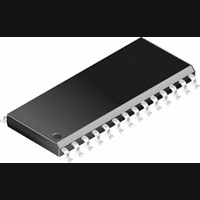CS8420-CS Cirrus Logic Inc, CS8420-CS Datasheet - Page 72

CS8420-CS
Manufacturer Part Number
CS8420-CS
Description
Transceiver IC
Manufacturer
Cirrus Logic Inc
Datasheet
1.CS8420-CS.pdf
(80 pages)
Specifications of CS8420-CS
Audio Control Type
Sample Rate Converter
Supply Voltage Range
4.75V To 5.25V
Operating Temperature Range
-10°C To +70°C
Audio Ic Case Style
SOIC
No. Of Pins
28
Msl
MSL 2 - 1 Year
Frequency Max
108GHz
Bandwidth
20kHz
Rohs Compliant
No
Lead Free Status / RoHS Status
Contains lead / RoHS non-compliant
Available stocks
Company
Part Number
Manufacturer
Quantity
Price
Company:
Part Number:
CS8420-CS
Manufacturer:
CRY
Quantity:
5 510
Company:
Part Number:
CS8420-CS
Manufacturer:
CIRRUS
Quantity:
225
Part Number:
CS8420-CS
Manufacturer:
CRYSTAL
Quantity:
20 000
Company:
Part Number:
CS8420-CS*
Manufacturer:
NEC
Quantity:
700
Company:
Part Number:
CS8420-CSZ
Manufacturer:
CIRRUS
Quantity:
319
Company:
Part Number:
CS8420-CSZ
Manufacturer:
CIRRUS
Quantity:
9 908
Part Number:
CS8420-CSZ
Manufacturer:
CIRRUS
Quantity:
20 000
16.
The CS8420 has a comprehensive channel status
(C) and user (U) data buffering scheme, which al-
lows automatic management of channel status
blocks and user data. Alternatively, sufficient con-
trol and access is provided to allow the user to com-
pletely manage the C and U data via the control
port.
16.1 AES3 Channel Status(C) Bit
The CS8420 contains sufficient RAM to store a full
block of C data for both A and B channels (192x2
= 384 bits), and also 384 bits of U information. The
user may read from or write to these RAMs via the
control port.
Unlike the audio data, it is not possible to ’sample-
rate’ convert the C bits. This is because specific
meanings are associated with fixed-length data pat-
terns, which should not be altered. Since the output
data rate of the CS8420 will differ from the input
rate when sample-rate conversion is done, it is not
feasible to directly transfer incoming C data to the
output. The CS8420 manages the flow of channel
status data at the block level, meaning that entire
blocks of channel status information are buffered at
the input, synchronized to the output timebase, and
then transmitted. The buffering scheme involves a
cascade of 3 block-sized buffers, named D,E and F,
72
AND USER DATA BUFFER
MANAGEMENT
APPENDIX B: CHANNEL STATUS
Management
From
AES3
Receiver
Received
Data
Buffer
Figure 39. Channel Status Data Buffer Structure
D
8-bits
A
Control Port
words
E
8-bits
24
as shown in Figure 39. The MSB of each byte rep-
resents the first bit in the serial C data stream. For
example, the MSB of byte 0 (which is at control
port address 32) is the consumer/professional bit
for channel status block A.
The first buffer, D, accepts incoming C data from
the AES receiver. The 2nd buffer, E, accepts entire
blocks of data from the D buffer. The E buffer is
also accessible from the control port, allowing read
and writing of the C data. The 3rd buffer (F) is used
as the source of C data for the AES3 transmitter.
The F buffer accepts block transfers from the E
buffer.
If the input rate is slower than the output rate (so
that in a given time interval, more channel status
blocks are transmitted than received), some buff-
ered C blocks will be transmitted multiple times. If
the input rate is faster than the output rate, some
will not be transmitted at all. This is illustrated in
Figure 40). In this manner, channel status block in-
tegrity is maintained. If the transmitted sample
count bits are important in the application, then
they will need to be updated via the control port by
the microcontroller for every outgoing block.
16.1.1 Manually accessing the E buffer
The user can monitor the data being transferred by
reading the E buffer, which is mapped into the reg-
ister space of the CS8420, via the control port. The
user can modify the data to be transmitted by writ-
ing to the E buffer.
B
Transmit
Data
Buffer
F
To
AES3
Transmitter
CS8420
DS245PP2



















